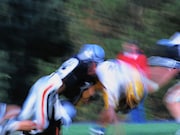Near point of convergence measured in players during a single high school football season
THURSDAY, Dec. 27, 2018 (HealthDay News) — Near point of convergence (NPC) values change in response to subconcussive head impacts but begin to normalize over time in high school football players, according to a study published online Dec. 20 in JAMA Ophthalmology.
Steven W. Zonner, D.O., from the Washington Township Medical Foundation in Union City, California, and colleagues collected repeated measurements in 12 varsity high school football players (mean age, 16.4 years) to assess NPC response to recurring subconcussive head impacts. The researchers collected measurements at pregame and postgame points during six in-season games plus postseason follow-up measurements. During practices and games, an accelerometer-embedded mouth guard measured head impact frequency and magnitude.
The researchers found that 8,009 head impacts, 177,907 g of peak linear acceleration, and 16,123,371 rad/s2 of peak rotational acceleration were recorded in a single football season. Over time, there was a significant increase in NPC until the middle of the season (mean NPC, baseline, 5.25 cm; pregame 3, 6.42 cm), which was significantly associated with subconcussive head impact frequency and magnitude (0.02 cm per 100 g of peak linear acceleration; 0.023 cm per 10,000 rad/s2 of peak rotational acceleration). From midseason on, NPC values began to normalize toward baseline even though participants continued to incur subconcussive head impacts.
“The oculomotor system may have an adaptational capacity to subclinical head impacts, yet the mechanism for such remains an open question and warrants further investigation,” the authors write.
One author disclosed current financial ties to Athlete Intelligence, a sports data and analytics company.
Copyright © 2018 HealthDay. All rights reserved.








